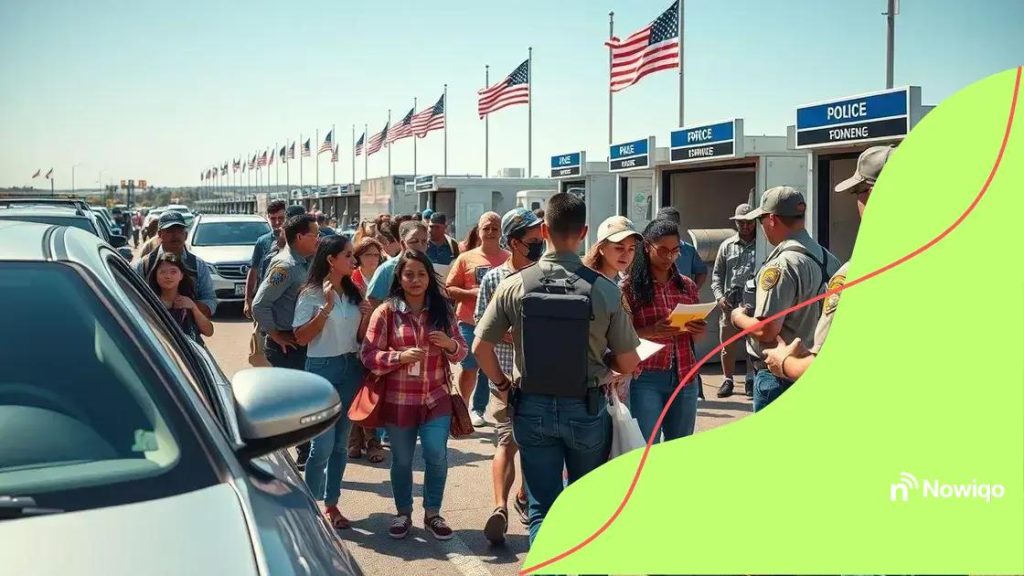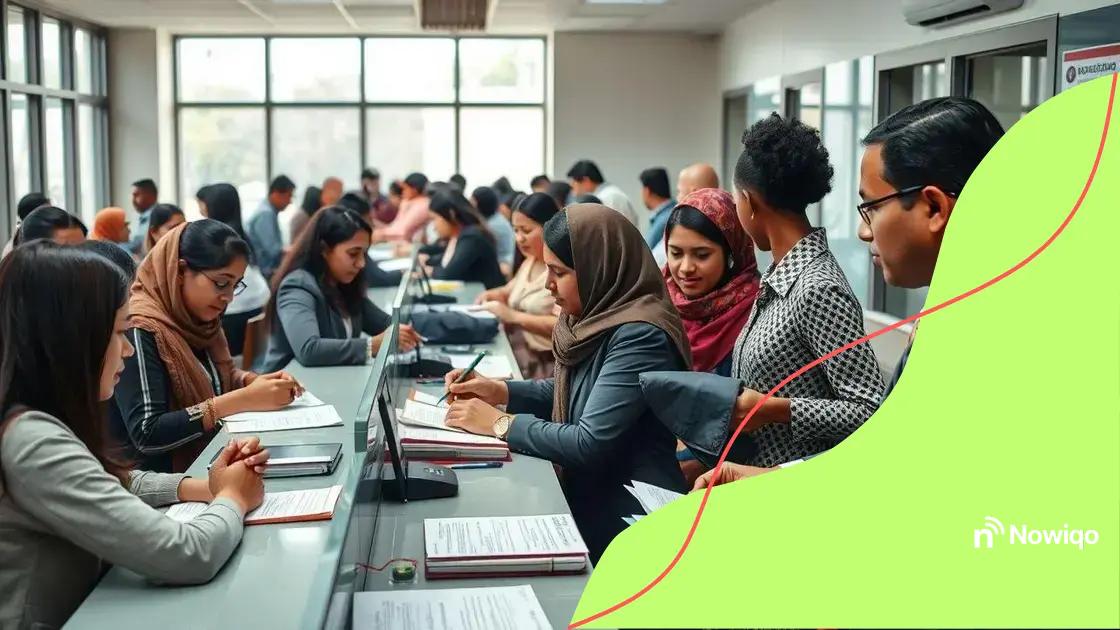Changes ahead for U.S. border policies: what to expect

Anúncios
Changes ahead for U.S. border policies aim to enhance security and streamline immigration processes while addressing the needs of border communities and individuals impacted by these shifting regulations.
Changes ahead for U.S. border policies are on the horizon, shaking up the landscape of immigration and security. Have you considered how these shifts might impact your community and the nation as a whole? Let’s dive into what you need to know.
Anúncios
Understanding the current U.S. border policies
Understanding the current U.S. border policies is essential for grasping the broader implications of migration and security. These policies shape how individuals enter and reside in the country, making this topic significant.
Key Aspects of U.S. Border Policies
Border policies in the United States are complex and often evolving. They determine everything from the processing of asylum seekers to the logistics of border security. Let’s look at some key elements:
- Immigration Procedures: The processes for legal entry, including visas and permits, are strictly enforced.
- Asylum Regulations: Policies outline who qualifies for asylum and the necessary steps to apply.
- Border Security Measures: This includes the physical infrastructure at borders and technologies used to monitor crossings.
- Deportation Processes: Procedures for removing individuals without legal status are a crucial part of these policies.
In recent years, the U.S. has implemented several changes aimed at addressing the challenges and complexities of immigration. These adjustments often reflect ongoing debates about security, human rights, and economic factors.
Anúncios
Another important factor is how community resources are allocated in response to policy changes. Localities may adapt by increasing support services or law enforcement measures, which can have significant impacts on residents and newcomers alike.
The Role of Agencies
Multiple agencies are involved in shaping U.S. border policies, each with distinct responsibilities. Understanding these roles helps demystify how policies develop and change:
- Department of Homeland Security: Leads efforts in immigration enforcement and policy formulation.
- Customs and Border Protection: Responsible for securing U.S. borders and facilitating lawful trade and travel.
- U.S. Citizenship and Immigration Services: Oversees lawful immigration benefits, such as citizenship and work permits.
As we watch these agencies interact, it’s clear that public opinion and political pressures also influence border policy decisions, making it a dynamic field. Change is often met with both support and opposition, reflecting the diverse perspectives within the country.
Key changes expected in U.S. border policies
Key changes expected in U.S. border policies are pivotal for understanding the future of immigration and safety. These shifts are often influenced by political and social factors and aim to address pressing issues at the border.
Anticipated Changes in Policy
Recent discussions around border policies highlight potential adjustments that could reshape how immigration is managed in the U.S. Some of these changes may include:
- Streamlined Asylum Processes: There is a push for reforms to make the asylum application process faster and more efficient.
- Enhanced Security Measures: Expectations for increased surveillance and security technologies are on the rise, affecting border crossings.
- Policy Adjustments to Family Separations: Future policies may seek to address and rectify the controversial practice of family separations at the border.
- Collaborations with Neighboring Countries: Increased international cooperation to manage migration flows and share resources could be a focal point of the new policies.
While these expected changes aim to improve border management, they stir up discussions about ethics and human rights. Communities at the borders are particularly affected, leading to various responses from local governments and activists.
The adjustment of these policies is not merely a bureaucratic process; it impacts real lives. For instance, families in border regions experience heightened anxiety as they navigate these changes and their implications. Additionally, successful policy implementation will depend on local support and resources, making it crucial for communities to engage in the dialogue.
The Role of Public Opinion
Public sentiment plays a significant role in shaping border policy changes. Issues such as immigration reform spark debates across the nation, influencing lawmakers. When communities voice their concerns and needs, it can lead to meaningful dialogue that shapes future policies.
- Community Outreach Programs: Local efforts can help raise awareness and impact public perceptions about migration.
- Advocacy Groups Mobilization: Activist organizations play a key role in ensuring that the voices of affected individuals are heard by decision-makers.
- Feedback Mechanisms: Establishing channels for citizens to express their views on border policies helps policymakers stay informed.
Changes in U.S. border policies are anticipated to continue evolving. Keeping a close eye on these developments is essential for understanding how immigration laws will influence both individuals and communities across the nation.
Impact of changes on immigration processes

The impact of changes on immigration processes is significant and multifaceted. As new policies are introduced, they will directly affect how individuals navigate the immigration system.
Changes in Application Procedures
With the anticipated changes in border policies, application procedures are likely to evolve. Individuals looking to immigrate will need to understand these shifts to prepare adequately. For instance, there may be:
- Quicker Processing Times: Streamlined procedures could lead to faster processing of visa applications.
- Updated Documentation Requirements: New policies may change what documents are needed for immigration applications.
- Increased Scrutiny: Certain applications might undergo more thorough reviews, affecting approval rates.
- Accessibility to Legal Aid: Changes could open more avenues for legal assistance during the application process.
These adjustments will significantly impact how prospective immigrants approach their applications. With potential for quicker processing, more people may feel encouraged to apply, which could lead to increased immigration levels.
Furthermore, it’s vital to recognize the emotional impact on individuals and families during these transitional periods. Uncertainty about new rules can create stress and anxiety, highlighting the need for clear communication from immigration authorities.
Effects on Asylum Seekers
The evolving landscape of U.S. border policies will especially affect asylum seekers, who often face unique challenges. Changes may lead to:
- Re-evaluation of Asylum Criteria: New policies might alter the standards by which asylum claims are assessed.
- Increased Support Services: Communities might offer more resources for individuals navigating these new asylum processes.
- Impact on Legal Representation: Changes could affect the availability and roles of nonprofit organizations assisting asylum seekers.
As these changes unfold, understanding their implications will be crucial for those seeking asylum and the agencies that assist them. The immigration landscape is always in flux, and staying informed is vital for all stakeholders involved.
How these changes affect border communities
How these changes affect border communities is a critical area of focus as new policies emerge. These communities are often directly impacted by shifts in immigration procedures and border enforcement.
Economic Impacts
As border policies change, the economic landscape for border communities also shifts. Many local economies rely on cross-border trade and travel. This can lead to:
- Changes in Business Operations: Local businesses may experience fluctuations in customer volume due to altered border crossing procedures.
- Employment Opportunities: Changes in immigration policies can create job openings or losses, significantly affecting employment rates.
- Impact on Tourism: Increased regulations can deter tourists and travelers, reducing revenue for local attractions and businesses.
The ebb and flow of these economic factors can lead to uncertainty and anxiety for residents. For example, small business owners might worry about sustaining their operations without a steady influx of customers from across the border.
Social Dynamics
In addition to economic changes, the social dynamics within border communities are also transformed. These shifts can include:
- Increased Community Tensions: Changes in policy may lead to divisions among residents regarding immigration and border security.
- Support Services Demand: An increase in the need for legal aid and mental health services can arise as individuals navigate new policies.
- Community Activism: Local organizations may mobilize to advocate for more humane immigration policies and support affected families.
The emotional strain on these communities can’t be overlooked. Families may face the stress of uncertainty and the fear of separation due to stricter enforcement. This reality makes it essential for local leaders to find ways to support their residents through these changes.
Moreover, the relationships between families in border communities can become more complex, as some family members might face different treatment under new policies. Understanding and addressing these social changes can help nurture community cohesion and resilience.
Future outlook for U.S. border security
The future outlook for U.S. border security is a topic of great importance as policies continue to evolve. As new challenges arise, the framework of border security is expected to adapt to address these needs effectively.
Technological Advancements
One major factor influencing border security is the integration of advanced technology. New tools can enhance monitoring and enforcement measures. Some of the expected innovations include:
- Biometric Identification Systems: These systems will likely become more common at border crossings, aimed at improving security checks.
- Drone Surveillance: Drones are anticipated to play an increasing role in monitoring border areas that are hard to access.
- Automated Processing Stations: AI-driven systems could streamline the processing of travelers, making border crossings quicker and safer.
The impact of these technologies can lead to more efficient security operations, but they also raise important questions about privacy and civil liberties. Ongoing dialogues about the balance between security and individual rights will be crucial.
Policy Reforms
Future policy reforms will shape the contours of U.S. border security significantly. Discussions around immigration reform will play a vital role in these changes. Some areas of focus will likely include:
- Comprehensive Immigration Reform: Policymakers may propose comprehensive reforms addressing both security and humanitarian concerns.
- Collaboration with International Partners: Enhanced cooperation with neighboring countries can lead to stronger security measures while supporting responsible migration.
- Resource Allocation: Adequate funding for border security initiatives is essential to ensure effective implementation of new policies.
The effectiveness of border security will hinge on the ability to adapt to changing circumstances. This includes preparing for unforeseen challenges, such as natural disasters or sudden increases in migration flows. Flexibility in policy and practice will be key.
Moreover, the voice of the community will remain vital in discussions about future border security. Engaging with those directly affected by policies will create more holistic solutions that respect both security needs and humanitarian values.
FAQ – Frequently Asked Questions about U.S. Border Policies
What are the key changes expected in U.S. border policies?
Key changes may include streamlined asylum processes, enhanced security measures, and updated immigration application procedures.
How will these changes affect border communities?
Border communities may experience economic impacts, social dynamics shifts, and increased demand for support services due to changes in policies.
What role does technology play in future border security?
Technological advancements such as biometric systems and drone surveillance are expected to enhance monitoring and improve efficiency at border crossings.
Why is community engagement important in policy development?
Engaging communities ensures that the voices of those directly affected by border policies are heard, leading to more balanced and effective solutions.